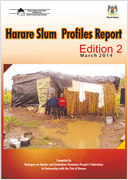Harare Slum Profiles Report

This reports on conditions in 60 informal settlements in and around Harare, with details for each of their locations (so many of them far away from the city centre), origin (many formed by those evicted from other sites had large increases in their population from evictees), population, land area, who owns the land, residents’ land tenure (or lack of it), housing, provision for water and sanitation (or lack of this; open defecation is common in many of the settlements), service provision (schools and health care) and economic base.
It was prepared for the Harare Slum Upgrading Project being implemented by the City of Harare and the Dialogue on Shelter and Zimbabwe Homeless People’s Federation with support from the Bill and Melinda Gates Foundation. It is part of the Federation’s programme to improve conditions for those living in informal settlements including improvements in shelter, infrastructure, services, land tenure, livelihoods and response to HIV/AIDS.
The profiling of slums/informal settlements is to provide the basic information for upgrading and to make visible the people and communities living in these. It includes the collection of social and economic data during community meetings and mapping. The information collected for each community is returned to it for checking and for its own use. Where more detail is needed, for instance to provide more detailed data needed for house upgrading, house-to-house enumerations are undertaken where data are collected from each household.
The slum profiling involves:
· identification – locating the geographical positioning of each slum in and around Harare through field visits.
· sensitization – explaining the whole process of slum profiling and its vision to the residents.
· profiling – gathering general information about the settlement, focusing on its historical evolution, tenure status, development facilities and demographics.
· mapping – capturing the spatial information about the slum settlement including its location and extent. The data from this exercise are to be integrated into the city maps to help assess the possibilities for upgrading.
· enumeration – the collection of detailed information from each household within the informal settlement.
· feedback – report-back meetings with the communities to verify the compiled information as well as following up on other activities such as mobilization, support for the formation of housing savings schemes and defining next courses of action.
Overall, this provides a rich and detailed picture of different informal settlements, showing both common features and features very specific to a settlement – for instance in relation to size, population, location and land tenure. The largest informal settlement covered is Epworth, with 31,000 households. Several others have over 1,000 households while close to half have fewer than 50. Some common characteristics include very inadequate provision for water (often a tap shared with many other households or a well or borehole), pit latrines shared by many households, and no school or health centre in the settlement or nearby.
It has many reminders of the vast scale of Operation Murambatsvina in 2005, which evicted hundreds of thousands of people, since so many of these settlements were founded by people evicted by this operation.
At the end, there is a valuable summary table with details of each of the profiled settlements and a list of those who took part in the slum profiles.
Available from: http://pubs.iied.org/G03861.html
For further reading on slum profiling, see www.sdinet.org – especially http://www.sdinet.org/method-community-planning/
For a detailed “slum inventory” on Nairobi, see http://www.irinnews.org/pdf/nairobi_inventory.pdf and http://www.citiesalliance.org/sites/citiesalliance.org/files/CA_Docs/resources/Nairobi%20Inventory/NairobiInventory_fullversion.pdf
For many papers on slum surveys and enumerations, see http://eau.sagepub.com/content/24/1.toc
Search the Book notes database
Our Book notes database contains details and summaries of all the publications included in Book notes since 1993 - with details on how to obtain/download.
Use the search form above, or visit the Book notes landing page for more options and latest content.
For a searchable database for papers in Environment and Urbanization, go to http://eau.sagepub.com/

